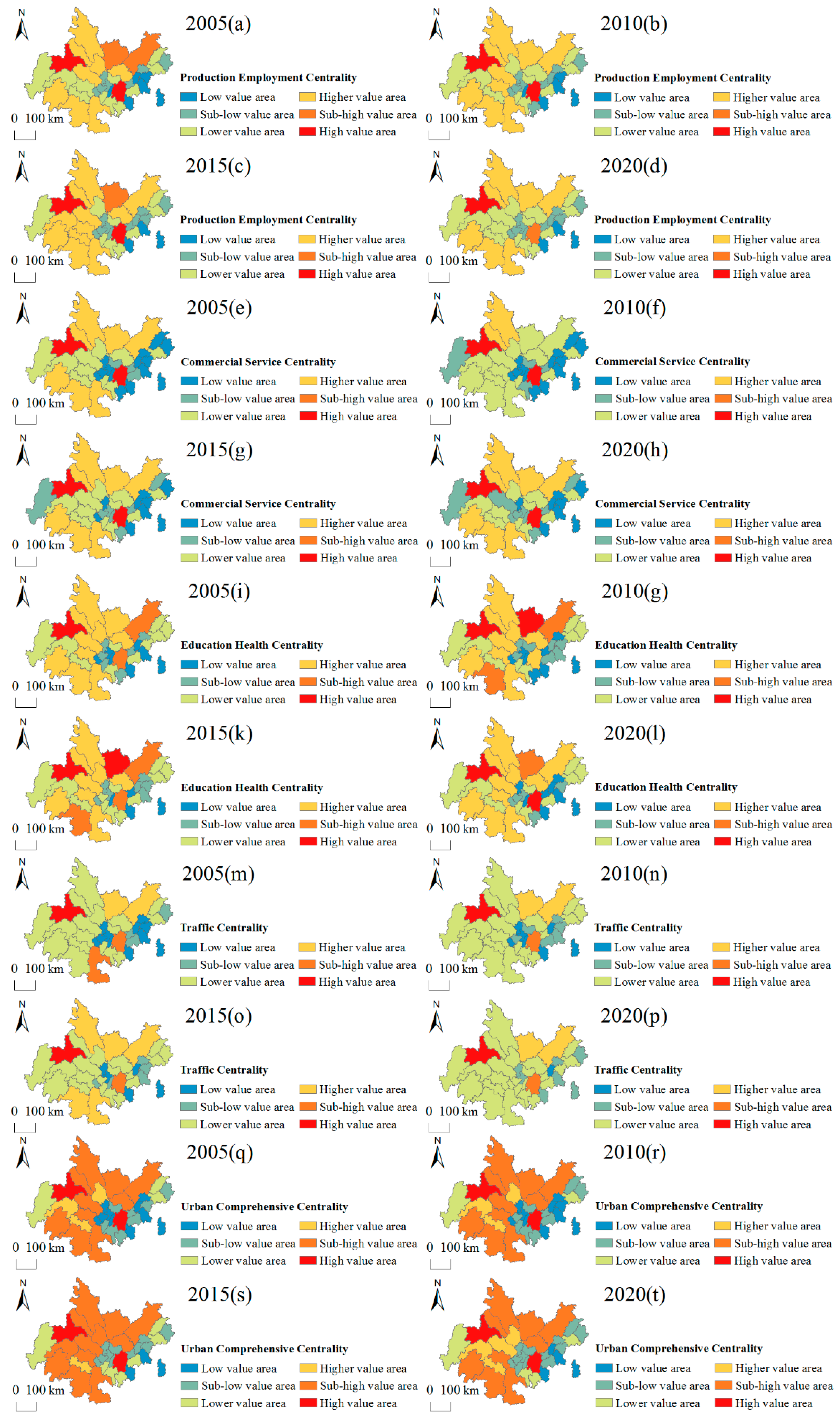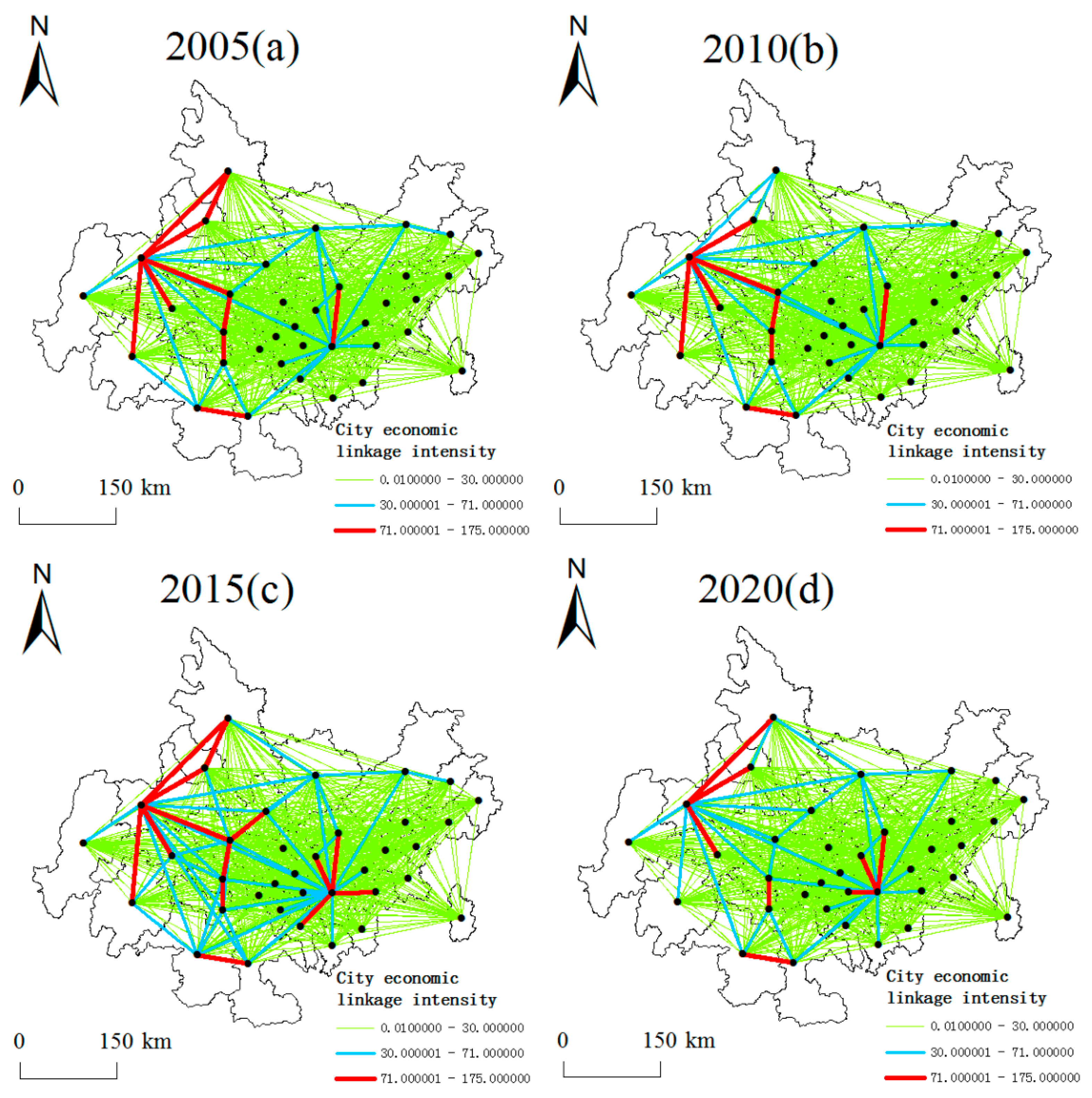Research on the Evolution of the Economic Spatial Pattern of Urban Agglomeration and Its Influencing Factors, Evidence from the Chengdu-Chongqing Urban Agglomeration of China
Abstract
:1. Introduction
2. Data and Methods
2.1. Overview of the Study Area
2.2. Selection of Indicators and Data Sources
2.3. Research Methodology
2.3.1. Network Construction Methods
2.3.2. Gravitational Model
2.3.3. Geo-Detectors
2.3.4. Geographically Weighted Regression (GWR)
3. Analysis of the Spatial Pattern of the Chengdu-Chongqing Urban Agglomeration
3.1. Analysis of the Centrality of Chengdu-Chongqing Urban Agglomeration
3.2. Analysis of the Economic Development Level of Each City in the Chengdu-Chongqing Urban Agglomeration
4. Analysis of the Intensity of Economic Linkages of Chengdu-Chongqing Urban Agglomeration
4.1. Analysis of the Linkages Volume and the Proportion of the Linkages Volume in the Chengdu-Chongqing Urban Agglomeration
4.2. Analysis on the Spatial-Temporal Pattern of Linkages Intensity of Cities in Chengdu-Chongqing Urban Agglomeration
5. Analysis of the Factors Influencing the Economic Development of the Chengdu-Chongqing Urban Agglomeration
5.1. Analysis of Impact Factor Geographic Detector Results
5.2. Analysis of Spatial Variation in the Role of Influencing Factors
6. Conclusions and Recommendations
6.1. Main Conclusions
6.2. Recommendations
Author Contributions
Funding
Data Availability Statement
Acknowledgments
Conflicts of Interest
References
- Chen, Y.; Miao, Q.; Zhou, Q. Spatiotemporal Differentiation and Driving Force Analysis of the High-Quality Development of Urban Agglomerations along the Yellow River Basin. Int. J. Environ. Res. Public Health 2022, 19, 2484. [Google Scholar] [CrossRef] [PubMed]
- Yu, S.; Kim, D. Changes in Regional Economic Resilience after the 2008 Global Economic Crisis: The Case of Korea. Sustainability 2021, 13, 11392. [Google Scholar] [CrossRef]
- Hua, X.Y.; Lv, H.P.; Jin, X.R. Research on High-Quality Development Efficiency and Total Factor Productivity of Regional Economies in China. Sustainability 2021, 13, 8287. [Google Scholar] [CrossRef]
- Li, Y.; Shao, H.; Jiang, N.; Shi, G.; Cheng, X. The Evolution of the Urban Spatial Pattern in the Yangtze River Economic Belt: Based on Multi-Source Remote Sensing Data. Sustainability 2018, 10, 2733. [Google Scholar] [CrossRef]
- Panzera, D.; Postiglione, P. Measuring the Spatial Dimension of Regional Inequality: An Approach Based on the Gini Correlation Measure. Soc. Indic. Res. 2019, 148, 379–394. [Google Scholar] [CrossRef]
- Panzera, D.; Postiglione, P. The impact of regional inequality on economic growth: A spatial econometric approach. Reg. Stud. 2021, 56, 687–702. [Google Scholar] [CrossRef]
- Zhang, B.; Wang, M.M. How Will the Improvements of Electricity Supply Quality in Poor Regions Reduce the Regional Economic Gaps? A Case Study of China. Energies 2021, 14, 3456. [Google Scholar] [CrossRef]
- Chen, L.; Shen, W. Spatiotemporal differentiation of urban-rural income disparity and its driving force in the Yangtze River Economic Belt during 2000–2017. PLoS ONE 2021, 16, e0245961. [Google Scholar] [CrossRef]
- Zhang, M.; Xiao, H.; Sun, D.Q.; Li, Y. Spatial Differences in and Influences upon the Sustainable Development Level of the Yangtze River Delta Urban Agglomeration in China. Sustainability 2018, 10, 411. [Google Scholar] [CrossRef]
- Lan, F.; Da, H.; Wen, H.; Wang, Y. Spatial Structure Evolution of Urban Agglomerations and Its Driving Factors in Mainland China: From the Monocentric to the Polycentric Dimension. Sustainability 2019, 11, 610. [Google Scholar] [CrossRef] [Green Version]
- Ding, R.; Zhang, T.; Yin, J.; Zhang, Y.L.; Li, T.F. Study on the characteristics and toughness of the Urban Network structure of the New Land-Sea Corridor in West China. J. Beijing Norm. Univ. 2021, 8, 794–802. [Google Scholar] [CrossRef]
- Yang, Z.K.; Hua, Y.X.; Cao, Y.B.; Zhao, X.K.; Chen, M.J. Network Patterns of Zhongyuan Urban Agglomeration in China Based on Baidu Migration Data. ISPRS Int. J. Geo-Inf. 2022, 11, 62. [Google Scholar] [CrossRef]
- Ye, S.S.; Cao, M.M.; Hu, S. Study on the evolution of economic connection network structure of urban agglomeration in Guanzhong Plain and its impact on economic growth. ARID Land Geogr. 2022, 45, 277–286. [Google Scholar]
- Guo, J.K.; Wang, Y.; Wang, Y.; Gao, H.H.; Li, F.X. Research on urban connection network structure in Northeast China based on "High-Speed Rail +" network. Geogr. Geo-Inf. Sci. 2021, 37, 51–56. [Google Scholar] [CrossRef]
- Lin, Q.W.; Xiang, M.Y.; Zhang, L.; Yao, J.J.; Wei, C.; Ye, S.; Shao, H.M. Research on Urban Spatial Connection and Network Structure of Urban Agglomeration in Yangtze River Delta-Based on the Perspective of Information Flow. Int. J. Environ. Res. Public Health 2021, 18, 288. [Google Scholar] [CrossRef]
- Li, H.L.; Dai, H.W. Comparison of dynamic changes of economic ties between Beijing Tianjin Hebei and Yangtze River Delta Urban Agglomeration—From the perspective of urban flow intensity. Econ. Manag. 2016, 30, 9–16. [Google Scholar]
- Ren, H.; Li, Z.K. Influencing factors and spatial effects of economic growth in China’s three major urban agglomerations. Urban Issues 2019, 10, 63–68. [Google Scholar] [CrossRef]
- Tang, Z.Z.; Zhang, Z.X.; Zuo, L.J.; Wang, X.; Hu, S.G.; Zhu, Z.J. Spatial Econometric Analysis of the Relationship between Urban Land and Regional Economic Development in the Beijing–Tianjin–Hebei Coordinated Development Region. Sustainability 2020, 12, 8451. [Google Scholar] [CrossRef]
- Fu, Y.; Zhong, Y.X.; Feng, X.H. Evolution of regional structure in the Economic Belt of the Yangtze River. World Reg. Stud. 2018, 27, 65–75. [Google Scholar] [CrossRef]
- Wu, C.Y.; Huang, X.J.; Chen, B.W.; Li, J.B.; Xu, J. Spatial pattern of economic ties and trend of economic integration in the Yangtze River Economic Belt. Econ. Geogr. 2017, 37, 71–78. [Google Scholar] [CrossRef]
- Wang, J.T.; Liu, H.B.; Peng, D.; Lv, Q.; Sun, Y.; Huang, H.; Liu, H. The County-Scale Economic Spatial Pattern and Influencing Factors of Seven Urban Agglomerations in the Yellow River Basin—A Study Based on the Integrated Nighttime Light Data. Sustainability 2021, 13, 4220. [Google Scholar] [CrossRef]
- Zhong, Z.Q.; Peng, B.H.; Xu, L.; Andrews, A.; Elahi, E. Analysis of regional energy economic efficiency and its influencing factors: A case study of Yangtze river urban agglomeration. Sustain. Energy Technol. Assess. 2020, 41, 100784. [Google Scholar] [CrossRef]
- Wei, X.Y.; Hu, Q.G.; Shen, W.T.; Ma, J. Influence of the Evolution of Marine Industry Structure on the Green Total Factor Productivity of Marine Economy. Water 2021, 13, 1108. [Google Scholar] [CrossRef]
- Chen, X.D.; Wang, T.; Zheng, X.; Han, F.; Yang, Z.P. The Structure and Evolution of the Tourism Economic Network of the Tibetan Plateau and Its Driving Factors. Land 2022, 11, 241. [Google Scholar] [CrossRef]
- Wang, J.F.; Xu, C.D. Geographic detector: Principle and prospect. Acta Geogr. Sin. 2017, 72, 19. [Google Scholar] [CrossRef]







| Year | Moran’s I | Z-Value | p-Value |
|---|---|---|---|
| 2005 | 0.2825 | 3.8256 | 0.0001 |
| 2010 | 0.1192 | 1.7846 | 0.0743 |
| 2015 | 0.1210 | 1.8131 | 0.0698 |
| 2020 | 0.4198 | 5.2504 | 0.0000 |
| Year | 2005 | 2010 | 2015 | 2020 |
|---|---|---|---|---|
| Model goodness of fit | 0.730 | 0.733 | 0.795 | 0.793 |
| Calibration model goodness of fit | 0.666 | 0.651 | 0.760 | 0.766 |
| Partial R2 | 0.566~0.793 | 0.617~0.841 | 0.759~0.792 | 0.792~0.793 |
| Conditions | 14.869~29.993 | 21.268~29.990 | 25.982~29.997 | 23.803~23.829 |
Publisher’s Note: MDPI stays neutral with regard to jurisdictional claims in published maps and institutional affiliations. |
© 2022 by the authors. Licensee MDPI, Basel, Switzerland. This article is an open access article distributed under the terms and conditions of the Creative Commons Attribution (CC BY) license (https://creativecommons.org/licenses/by/4.0/).
Share and Cite
Ding, R.; Fu, J.; Zhang, Y.; Zhang, T.; Yin, J.; Du, Y.; Zhou, T.; Du, L. Research on the Evolution of the Economic Spatial Pattern of Urban Agglomeration and Its Influencing Factors, Evidence from the Chengdu-Chongqing Urban Agglomeration of China. Sustainability 2022, 14, 10969. https://doi.org/10.3390/su141710969
Ding R, Fu J, Zhang Y, Zhang T, Yin J, Du Y, Zhou T, Du L. Research on the Evolution of the Economic Spatial Pattern of Urban Agglomeration and Its Influencing Factors, Evidence from the Chengdu-Chongqing Urban Agglomeration of China. Sustainability. 2022; 14(17):10969. https://doi.org/10.3390/su141710969
Chicago/Turabian StyleDing, Rui, Jun Fu, Yiling Zhang, Ting Zhang, Jian Yin, Yiming Du, Tao Zhou, and Linyu Du. 2022. "Research on the Evolution of the Economic Spatial Pattern of Urban Agglomeration and Its Influencing Factors, Evidence from the Chengdu-Chongqing Urban Agglomeration of China" Sustainability 14, no. 17: 10969. https://doi.org/10.3390/su141710969








